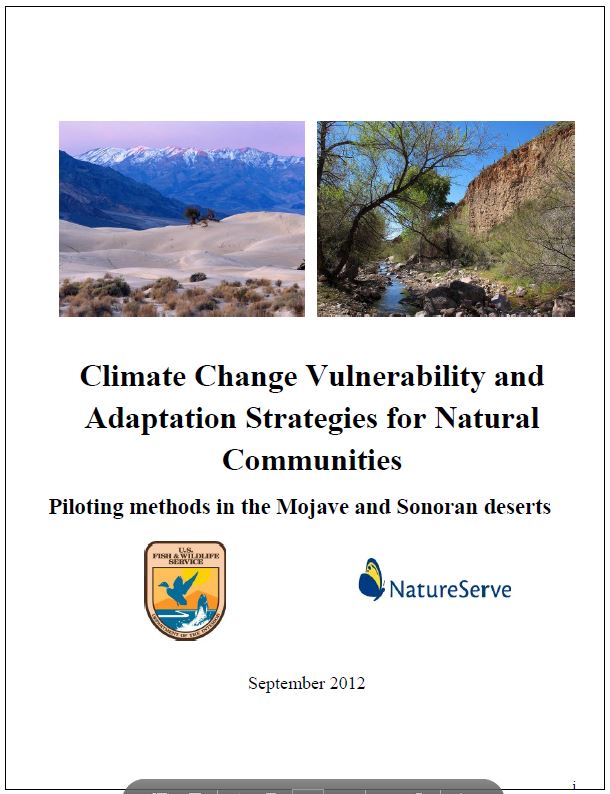 NatureServe worked with several federal, state, and NGO partners in the United States and Mexico to conduct a climate change vulnerability assessment of major natural community types found within the Mojave and Sonoran Deserts. The project focused on ten major upland, riparian, and aquatic community types, including pinyon-juniper woodlands, Joshua tree-blackbrush scrub, creosote-bursage scrub, salt desert scrub, Paloverde-mixed cacti scrub, semi-desert grassland, desert riparian and stream, riparian mesquite bosque, and desert springs. This effort piloted a new Habitat Climate Change Vulnerability Index (HCCVI) approach being developed by NatureServe, as a companion to an existing index for species. The project utilized existing data, much of which had been recently developed through the Bureau of Land Management’s rapid ecoregional assessments, or by ongoing research efforts with FWS, NPS, and USGS. Once vulnerability assessments were drafted, an expert workshop was held to review and revise the assessments, and then apply the findings to identify climate change adaptation strategies applicable across managed lands within each ecoregion.
NatureServe worked with several federal, state, and NGO partners in the United States and Mexico to conduct a climate change vulnerability assessment of major natural community types found within the Mojave and Sonoran Deserts. The project focused on ten major upland, riparian, and aquatic community types, including pinyon-juniper woodlands, Joshua tree-blackbrush scrub, creosote-bursage scrub, salt desert scrub, Paloverde-mixed cacti scrub, semi-desert grassland, desert riparian and stream, riparian mesquite bosque, and desert springs. This effort piloted a new Habitat Climate Change Vulnerability Index (HCCVI) approach being developed by NatureServe, as a companion to an existing index for species. The project utilized existing data, much of which had been recently developed through the Bureau of Land Management’s rapid ecoregional assessments, or by ongoing research efforts with FWS, NPS, and USGS. Once vulnerability assessments were drafted, an expert workshop was held to review and revise the assessments, and then apply the findings to identify climate change adaptation strategies applicable across managed lands within each ecoregion.
Climate Change Vulnerability and Adaptation Strategies for Natural Communities: Piloting methods in the Mojave and Sonoran deserts
NatureServe
Citation
Comer PJ, Young B, Schulz K, Kittel G, Unnasch B, Braun D, Hammerson G, Smart L, Hamilton H, Auer S, Smyth R, and Hak J. 2012. Climate Change Vulnerability and Adaptation Strategies for Natural Communities: Piloting methods in the Mojave and Sonoran deserts. Report to the U.S. Fish and Wildlife Service. Arlington, VA: NatureServe.